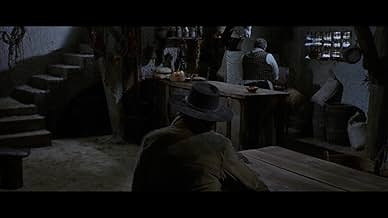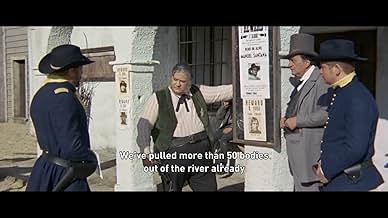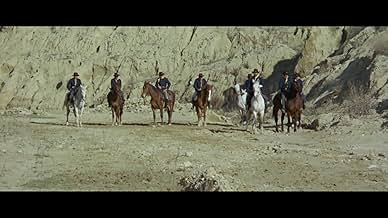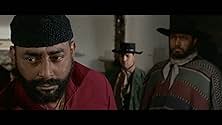Ajouter une intrigue dans votre langueDjango and Santana are bounty hunters taking out bandits in a small Western town. An evil landowner smuggling illegal immigrants and the men that work for him have mighty fine prices on thei... Tout lireDjango and Santana are bounty hunters taking out bandits in a small Western town. An evil landowner smuggling illegal immigrants and the men that work for him have mighty fine prices on their heads. So it only makes sense that Django and Santana would come-a-callin' before long.Django and Santana are bounty hunters taking out bandits in a small Western town. An evil landowner smuggling illegal immigrants and the men that work for him have mighty fine prices on their heads. So it only makes sense that Django and Santana would come-a-callin' before long.
- Réalisation
- Scénario
- Casting principal
- Gunman in Flashback
- (non crédité)
- Soldier
- (non crédité)
- Henchman
- (non crédité)
- Innkeeper
- (non crédité)
- Fargo's Bodyguard
- (non crédité)
- Burt Kelly
- (non crédité)
- Carl Smart
- (non crédité)
Avis à la une
Fargo's number might be up due to the appearance of a couple of bounty hunters; The good natured but deadly Anthony Steffen, who starts off by gunning down the bandit Sartana. The other bounty hunter is the not-so-good natured William Berger, a milk drinking preacher with a seven barrelled rifle who hunts down and kills a few wanted villians but is willing to meet up with Sartana to take down Fargo's gang, where there's a fair price on most of their heads.
There's a slight sub-plot involving the Mexican smuggling racket being exposed (where Mariangela Giordano gets a few shots in) but everything really boils down to Steffen and Berger taking on scores of Fargo's men in various situations, with a few double crosses thrown in for good measure (William Berger gets ripped off at one point and runs around screaming "C'mere! You can't steal from me - it's a sin!"). The plot might be the usual, but director Garrone throws in loads of weird camera angles and trippy visuals. It's a good companion piece to his Django The Bastard, and makes me wonder why he would go on to bore us to death with the horror films Lover of the Monster and The Hand that Feeds the Dead.
I'll watch anything with William Berger in it mind you. He's always got a cheeky look on his face, even when gunning down scores of bad guys.
A Noose for Django is one of the more difficult to find entries in the Django series, and that seems pretty apt it really isn't all that good. Naturally, the film features a plethora of violent gun fights and a handful of gritty characters; but nothing is really explained or done in any great detail, which really leaves the film feeling rather flat. Anthony Steffen gives a performance that is, in my opinion, better than the one he gave in Django the Bastard (albeit slightly); but it's spoiled by the fact that he's eclipsed by his rival bounty hunter and his very cool seven barrelled shotgun! Said gun represents what is probably the only real memorable thing about this film; which really says a lot for it. However, in typical Italian fashion; A Noose for Django compensates for its muddled and rather boring story with style. The atmosphere is dark and gritty and the locations, while obviously cheap, do help the film with regards to the atmosphere as it presents a very minimalist western style. Overall, I can't say that I liked this film very much and don't recommend tracking it down; although there may be something here for Spaghetti western fan.
Anthony Steffen is not the best actor in the genre but he does a satisfactory job here. William Berger is great as always! It contains more of the Django style multi-barrel guns and surreal sequences and moving camera shots with cool angles and experimental shots. The movie does contain some violence towards animals (there is a cockfight sequence).
Enjoyable Western follows the Sergio Leone wake , as it is proceeded in Spaghetti models . It's a moving western with breathtaking gunfight between the protagonists Anthony Steffen , William Berger against the heartless Riccardo Garrone , in addition a stirring ending fight in which takes place an impressive duel among three contenders in ¨The good , the bad , and the ugly¨ style . Acceptable action sequences with rousing attacks and spectacularly paced confrontation . Charismatic performance for the whole casting . The notorious Spaghetti actor , Anthony Steffen is good as Brandon . Anthony Steffen may be a name best remembered by Spaghetti Western aficionados, but in his day, from the mid-'60s to the early '70s, Steffen was one of the most popular actors of the genre - at the time cheap B movies, now revered cult classics . The handsome, Italian-born - actually at the Brazilian embassy in Rome - Antonio Luiz de Teffè von Hoonholtz began working in films as a studio messenger for Vittorio De Sica . From there, Steffen began acting in sword-and-sandal epics, later moving onto the Western genre , where he found his niche . Unlike fellow Spaghetti star Clint Eastwood, however, Steffen never became a top international box-office attraction .His acting is often accused of being wooden, but in many manners is ideally suited to playing the steely-faced gunslinger synonymous with the genre . His others successes include features as ¨Seven Dollars to Kill¨, ¨The last Mohican¨ or ¨The last Tomahawk¨, ¨Train for Durango¨, ¨Gentleman Jo¨ , ¨¨Stranger in Paso Bravo¨, ¨Garringo¨, ¨Four dollars for Django¨, ¨Shango¨, ¨Arizona colt¨, ¨Apocalypse Joe¨ and several others . Although he played other genres as Terror and Gialli , such as : ¨An angel for Satan¨ and ¨The night Evelyn came out of the grave¨ . And William Berger , the fair-haired Austrian leading man, who appeared in many spaghetti westerns between 1966 and 1987. He had a reputation for being a rebel and a vociferous anti-establishment figure . However , Berger's career was also at times interrupted by drug abuse. He played known Westerns as Face to face (1967), Keoma (1976) , Fast hand , The band of Jaider , Sabata , Chuncho , El Cisco , Today We Kill , Tomorrow We Die! , A Name That Cried Revenge. There appears as secondaries the habitual in Italian Western such as : Mario Brega , Giancarlo Sisti , Riccardo Garrone , and two gorgeous Eurothash girls : Nicoletta Machiavelli and Mariangela Giordano .
The musician Vasili Kojucharov and Elsio Mancuso compose a nice soundtrack in Morricole style and well conducted , this turns out to be one of the most memorable parts of the movie; as it's full of enjoyable sounds and haunting musical background . The soundtrack and songs contribute tremendously to the atmosphere of the film, including an emotive leitmotif, the music score is perhaps the best aspect of this movie . And adequate and atmospheric cinematography in Eastmancolor and CinemaScope by Franco Villa . The motion picture titled ¨Une langue file de croix ¨or ¨Una lunga fila di Croix¨ or ¨Una larga fila de cruces¨ was well filmed by Sergio Garrone and with lots of zooms , difficult angles , foregrounds , and backgrounds . Sergio's direction is finely crafted , here he is more inclined toward violence and packs some thrills and action , but especially this exciting Western contains moving shoot'em ups and some gloomy scenes when a lot of Mexican people are massacred . Sergio serves as a classic example of a journeyman Italian exploitation filmmaker and freelance screenwriter . As Garrone penned a great number of screenplays and lack-luster films , working from the 60s in all kind of genres and B movies . He directed this embarrassing western , genre in which he would not only excel but one where he would spent much of the rest of his career . Sergio went on to helm several other spaghetti Westerns , many of them Spanish co-productions, that include Tre Croci Per Non Morire (1968) , Quel Maledetto Giorno Della Resa Dei Conti (1971) , Deguello (1966) also starred by Jack Stuart , Huracan Sobre Mexico (1967) and his greatest notoriety was the peculiar outing : Django il Bastardo (1969) . In 1974 Garrone directed the horror features as Le Amanti del Mostro (1974) and La mano Che Nutre la Morte (1974) , both of which performed Klaus Kinski . He made and wrote for everything from inferior sex comedies as La Clinica Dell'Amore (1976) , El Periscopio (1979) by José Ramón Larraz , to even Giallo , mystery thrillers such as : L'ultimo harem , La Pagella , Blonde Köder Kür den Mörder (1969) or Killer's Gold . Later on , Sergio Garrone directed nasty Naziexploitation or Porno-Nazis as Lager SSadis Kastrat Kommandantur (1976) and SS Lager 5: L'inferno Delle Donne (1977). And after writing the violent/erotic WIPs (women-in-prison) : Hell Behind the Bars (1984) and Detenute Violente (1984)
Le saviez-vous
- ConnexionsFeatured in Due bounty killer per un massacro (2007)
Meilleurs choix
- How long is No Room to Die?Alimenté par Alexa
Détails
- Durée1 heure 37 minutes
- Mixage
- Rapport de forme
- 2.35 : 1
Contribuer à cette page



























